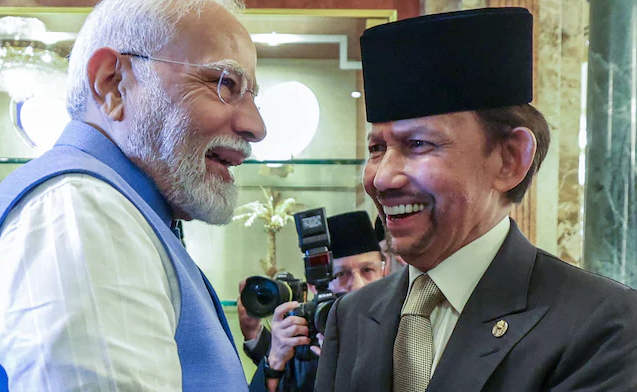Facing East: India’s Strategic Engagement with the Asia-Pacific (GS Paper 2, IR)

Context
- Prime Minister Narendra Modi’s recent visits to Brunei and Singapore, alongside President Droupadi Murmu’s travels to Fiji and New Zealand, underscore India’s intensified focus on the Asia-Pacific region.
- These visits, coupled with India's hosting of the prime ministers of Malaysia and Vietnam, highlight the burgeoning goodwill towards India in the region and the high expectations placed upon it.
From Look East to Act East
India’s engagement with the Asia-Pacific has evolved significantly since the early 1990s. Originally branded as the Look East Policy, the approach was redefined in 2014 as the Act East Policy, reflecting a more proactive and comprehensive strategy.
The transition from Look East to Act East was marked by several diplomatic milestones:
- ASEAN Leaders at Republic Day: In January 2018, India welcomed ASEAN leaders as honoured guests at the Republic Day celebrations, symbolizing its commitment to deepening ties with the region.
- Geopolitical Complexity: The geopolitical landscape has become increasingly complex, particularly with the intensifying US-China rivalry and India’s own strained relationship with China.
- QUAD Membership: India’s participation in the Quadrilateral Security Dialogue (QUAD) raised concerns among some regional players. During his visit to Singapore, PM Modi reassured ASEAN nations of India’s support for ASEAN’s central role in regional security.
India’s efforts to reassure ASEAN have borne fruit, as evidenced by the growing defense and security cooperation between India and the region.
The Trade Hurdle
Despite positive diplomatic engagement, significant challenges remain in the trade domain. India’s decision to withdraw from the Regional Comprehensive Economic Partnership (RCEP) negotiations at the eleventh hour disappointed several countries, particularly Singapore. The RCEP was intended to be a comprehensive trade agreement encompassing 15 Asia-Pacific nations.
- Trade Commitment: India’s exit from RCEP raised questions about its commitment to regional trade liberalization. Despite ongoing calls from the region and international organizations like the World Bank, India is unlikely to reconsider its stance on RCEP.
- Bilateral Arrangements: To address the trade gap, India is focusing on strengthening bilateral trade and investment agreements with major economies in the region. This strategy aims to enhance economic ties while navigating the complexities of regional trade agreements.
Way Forward: Expanding Engagement
India is pursuing new avenues to bolster its regional presence and influence, with a focus on areas that align with both its strategic interests and regional priorities. Key areas of focus include:
- Digitalization and Health: India aims to enhance collaboration in digital technologies and health sectors, reflecting mutual interests in advancing these critical areas.
- Space Technology: India’s advancements in space technology present opportunities for joint initiatives with regional partners.
- Advanced Manufacturing: The emphasis on advanced manufacturing aligns with India’s goal of integrating into global supply chains.
Semiconductor Diplomacy: A notable example is India’s engagement with Malaysia and Singapore in the field of semiconductor production. Both countries have significant capabilities in this sector, and India’s collaboration in semiconductor technology represents a strategic move to enhance technological cooperation and regional influence.
Conclusion
- India’s evolving engagement with the Asia-Pacific region reflects its strategic shift from a reactive to a proactive role in regional affairs.
- While diplomatic efforts have strengthened ties with key partners, trade challenges remain a critical issue.
- The focus on new areas such as digitalization, health, space technology, and advanced manufacturing represents a forward-looking approach to regional cooperation.
- Successful translation of these diplomatic engagements into concrete outcomes, particularly in emerging sectors like semiconductors, will be crucial for India’s long-term success in the Asia-Pacific region.
- Balancing diplomatic reassurances with trade commitments and expanding collaborative efforts will be essential for India to reinforce its position as a pivotal player in the regional landscape.


